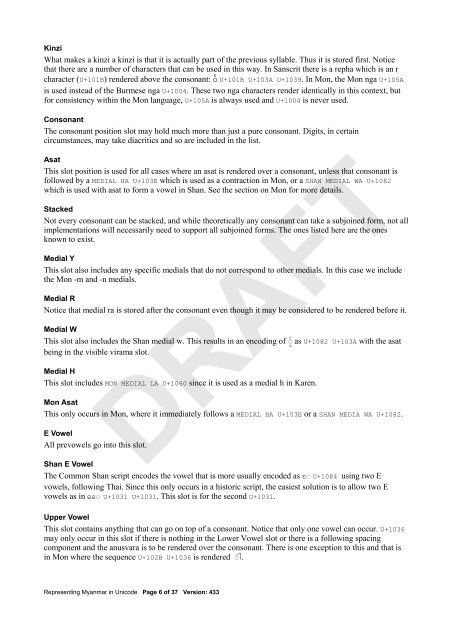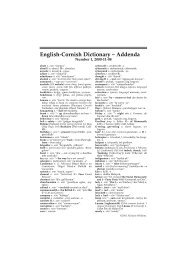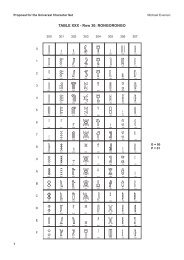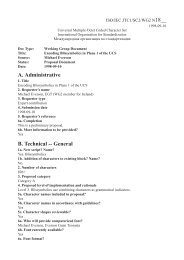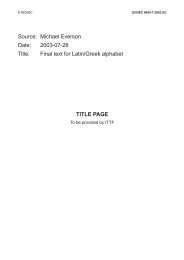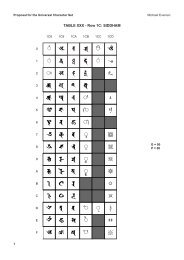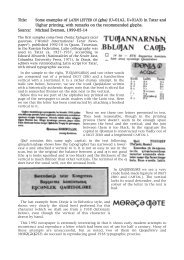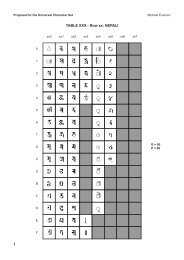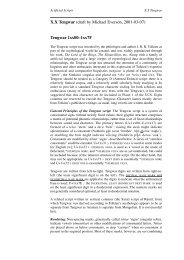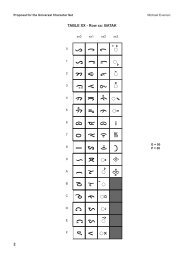Representing Myanmar in Unicode - Evertype
Representing Myanmar in Unicode - Evertype
Representing Myanmar in Unicode - Evertype
Create successful ePaper yourself
Turn your PDF publications into a flip-book with our unique Google optimized e-Paper software.
K<strong>in</strong>zi<br />
What makes a k<strong>in</strong>zi a k<strong>in</strong>zi is that it is actually part of the previous syllable. Thus it is stored first. Notice<br />
that there are a number of characters that can be used <strong>in</strong> this way. In Sanscrit there is a repha which is an r<br />
character (U+101B) rendered above the consonant: ဝရ U+101B U+103A U+1039. In Mon, the Mon nga U+105A<br />
is used <strong>in</strong>stead of the Burmese nga U+1004. These two nga characters render identically <strong>in</strong> this context, but<br />
for consistency with<strong>in</strong> the Mon language, U+105A is always used and U+1004 is never used.<br />
Consonant<br />
The consonant position slot may hold much more than just a pure consonant. Digits, <strong>in</strong> certa<strong>in</strong><br />
circumstances, may take diacritics and so are <strong>in</strong>cluded <strong>in</strong> the list.<br />
Asat<br />
This slot position is used for all cases where an asat is rendered over a consonant, unless that consonant is<br />
followed by a MEDIAL HA U+103E which is used as a contraction <strong>in</strong> Mon, or a SHAN MEDIAL WA U+1082<br />
which is used with asat to form a vowel <strong>in</strong> Shan. See the section on Mon for more details.<br />
Stacked<br />
Not every consonant can be stacked, and while theoretically any consonant can take a subjo<strong>in</strong>ed form, not all<br />
implementations will necessarily need to support all subjo<strong>in</strong>ed forms. The ones listed here are the ones<br />
known to exist.<br />
Medial Y<br />
This slot also <strong>in</strong>cludes any specific medials that do not correspond to other medials. In this case we <strong>in</strong>clude<br />
the Mon -m and -n medials.<br />
Medial R<br />
Notice that medial ra is stored after the consonant even though it may be considered to be rendered before it.<br />
Medial W<br />
This slot also <strong>in</strong>cludes the Shan medial w. This results <strong>in</strong> an encod<strong>in</strong>g of ါႂ ် as U+1082 U+103A with the asat<br />
be<strong>in</strong>g <strong>in</strong> the visible virama slot.<br />
Medial H<br />
This slot <strong>in</strong>cludes MON MEDIAL LA U+1060 s<strong>in</strong>ce it is used as a medial h <strong>in</strong> Karen.<br />
Mon Asat<br />
This only occurs <strong>in</strong> Mon, where it immediately follows a MEDIAL HA U+103E or a SHAN MEDIA WA U+1082.<br />
E Vowel<br />
All prevowels go <strong>in</strong>to this slot.<br />
Shan E Vowel<br />
The Common Shan script encodes the vowel that is more usually encoded as ႄါ U+1084 us<strong>in</strong>g two E<br />
vowels, follow<strong>in</strong>g Thai. S<strong>in</strong>ce this only occurs <strong>in</strong> a historic script, the easiest solution is to allow two E<br />
vowels as <strong>in</strong> နနါ U+1031 U+1031. This slot is for the second U+1031.<br />
Upper Vowel<br />
This slot conta<strong>in</strong>s anyth<strong>in</strong>g that can go on top of a consonant. Notice that only one vowel can occur. U+1036<br />
may only occur <strong>in</strong> this slot if there is noth<strong>in</strong>g <strong>in</strong> the Lower Vowel slot or there is a follow<strong>in</strong>g spac<strong>in</strong>g<br />
component and the anusvara is to be rendered over the consonant. There is one exception to this and that is<br />
<strong>in</strong> Mon where the sequence U+102B U+1036 is rendered ါံ ါ.<br />
<strong>Represent<strong>in</strong>g</strong> <strong>Myanmar</strong> <strong>in</strong> <strong>Unicode</strong> Page 6 of 37 Version: 433


